Fitbit Blaze: Fitness tracker or smartwatch? Gigantic hybrid can’t decide
In the beginning, there were step counters — those little gadgets that clipped to your clothes or wrapped on your wrist, with motion sensors (accelerometers) inside that counted your steps like glorified pedometers. This was the original Fitbit, and it was a hit.
Today, of course, those humble early gadgets have evolved into full-blown smartwatches. They count your steps, yes, but they also track your sleep, measure your pulse, track your running and biking routes via GPS, wake you up with vibrating alarms, and much more.
In short, wearables have differentiated: Some are for ordinary folks who just want a little motivation to move more. Some are for athletes who want to measure their physical endeavors with as much data as they can get.
And somewhere in between, somewhat unsure of its identity, there’s the new Fitbit Blaze ($200): a strange, mutant cross between fitness tracker and smartwatch.
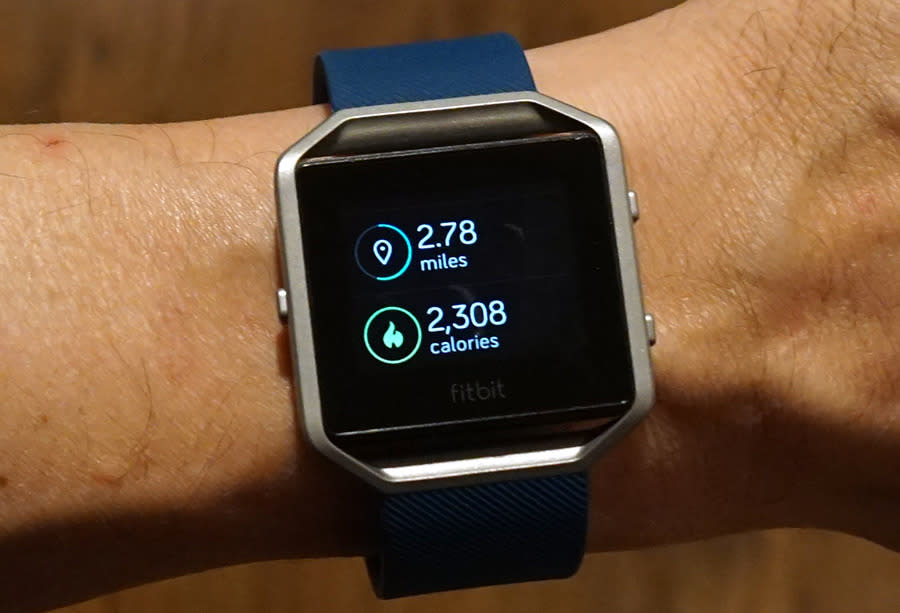
Fitness elements
The Blaze does everything other Fitbits do, such as accurately counting steps taken and flights of stairs climbed; sleep duration (and interruptions); and continuous heart-rate readings.
All that data shows up in Fitbit’s terrific app. (We shall overlook, for now, the two grammatical errors that appear on a single screen of its setup wizard.)

In addition, the Blaze offers a few new features (at least they’re new to the Fitbit line):
“Connected” GPS: Some fitness bands — including the Microsoft Band 2 ($175) and the Fitbit Surge ($220) — have built-in GPS, so you can go for a run or a bike ride without also bringing along your phone just to map your route. The Blaze does not. Instead, it communicates wirelessly with your phone.
This feature is a little weird: If you have to carry your phone anyway, what good is the band? The watch can’t display your route — only the phone can. I guess Fitbit’s answer would be that the watch can show you stats about distance covered and altitude changes after your run. Of course, your phone can do that, too. So…?
Built-in workout guidance: The watch can guide you through your choice of three workouts: a warmup, a seven-minute workout, or a 10-minute abdominal routine. None require any equipment.
A little animated figure on the screen shows how to do each exercise, and of course, the watch keeps track of the time and vibrates when you should move on to the next one.
I imagine you’ll get tired of these three routines pretty quickly.
Awareness of 17 different activities: Like the Alta, which I reviewed here, the Blaze can auto-detect which activities you’re doing: hiking, running, basketball, weights, and so on. Very slick.

However, at the moment the Blaze doesn’t remind you to move for a couple of minutes every hour, as the Alta does. Fitbit says that feature is coming soon.
Smartwatch elements
In other ways, the Blaze is like a smartwatch. It has a color touchscreen, for example. It shows the time (using your choice of four colorful displays) when you raise your wrist or press one of its three tiny buttons. Each of these screens also displays your current progress toward your daily step goal. The rest of the time, the screen stays dark, to preserve battery life.
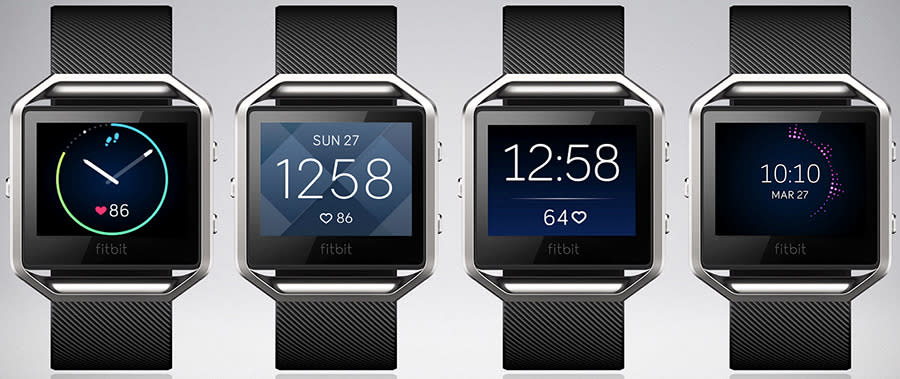
Also, like most smartwatches, the Blaze is splashproof but not showerproof. Dang it!
It also communicates with your iPhone, Android phone, or Windows 10 phone. So when you get a text message, it vibrates to let you know and displays the first 160 characters. You can’t, however, respond from the Blaze.
Similarly, when you get a phone call, it vibrates and shows you who’s calling. There’s no speaker or microphone, so you can’t answer or make a call, but you can send an incoming call to voicemail without having to reach for your phone.
When you have calendar appointments, it vibrates and shows them to you. The Blaze can also control music playback with Play/Pause and Next track/Previous track buttons. Depending on which app is playing, it can also show the name of the current song.
You can turn any and all of this off if you like.
What the Blaze is not
But here’s the thing: The Blaze isn’t actually a smartwatch. It doesn’t run apps. It can’t show you stocks, the weather, or your email; give you directions; or adjust your thermostat.
In some ways, that’s a blessing: The Blaze gets four days of battery life instead of one (which is typical for Apple and Android smartwatches). And it’s extremely lightweight and comfortable.
But in other ways, it’s just baffling. The Blaze isn’t really much more talented than my favorite Fitbit, the Charge HR ($125).
And yet the Blaze is huge. I mean, it almost completely covers the top of my wrist. If you put it on someone more petite, she might list to one side.

The Blaze is actually a square plastic tile, something like the old iPod Nano. It snaps in and out of a frame on the band.
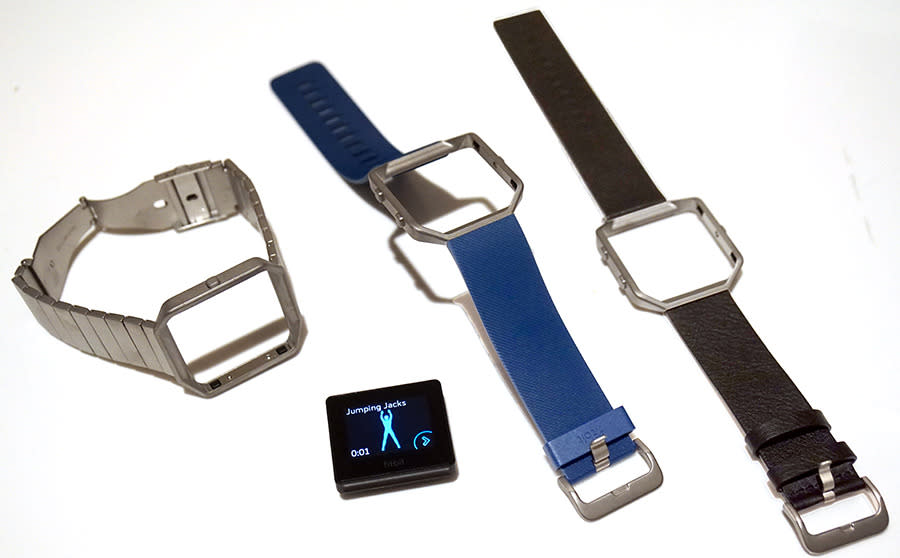
That design is a nod toward fashion: You can pop the tile in and out of different bands. You can choose silicone bands for $30 (black, blue, or purple), leather for $100 (black, gray, tan), or a metal link bands for $130.
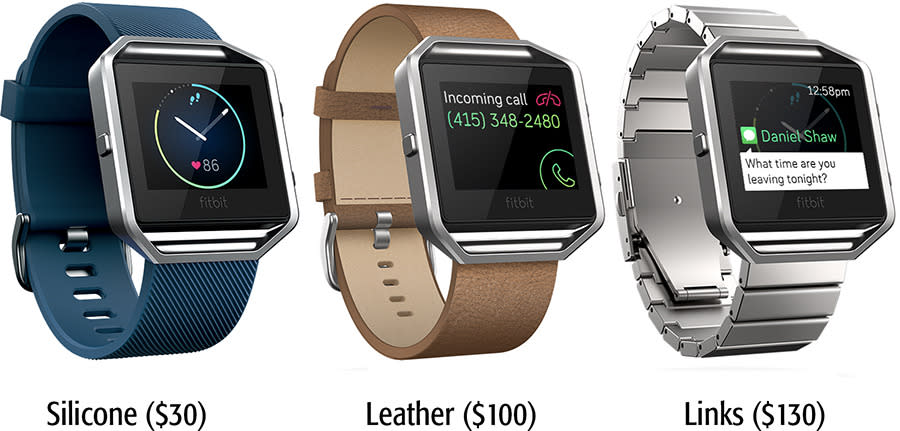
But the price you pay for that flexibility is an absolutely enormous footprint on your wrist. (A “wristprint”?) Overall, it’s just way too big and clunky.
What they were thinking
Fitbit’s rationale might have been, “Let’s put a big color screen on a basic fitness tracker.”
My guess, though, is that most people will think: “If I’m going to strap something that big and ugly onto my arm, it had better do a lot more than just basic fitness tracking.”
That’s what you get with gadgets like the Fitbit Surge, a Garmin Forerunner, a Garmin Vivoactive HR, or an Apple or Android smartwatch: either a lot more fitness features or a lot more smartwatch features.
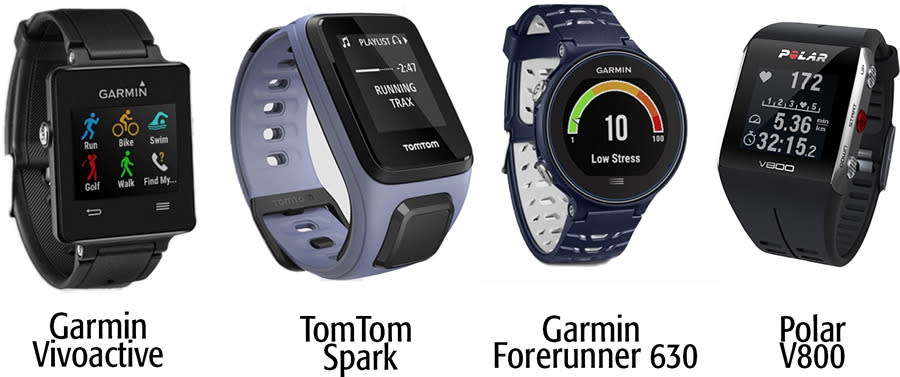
Sometimes mixing and matching features from two different product categories results in something better than either original: Think clock-radios, phone cameras, or peanut butter cups.
In the case of the Fitbit Blaze, though, the result is just a baffling Frankenstein.
David Pogue is the founder of Yahoo Tech; here’s how to get his columns by email. On the Web, he’s davidpogue.com. On Twitter, he’s @pogue. On email, he’s poguester@yahoo.com. He welcomes nontoxic comments in the Comments below.


